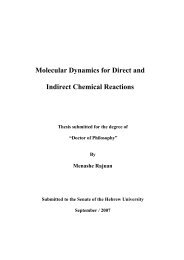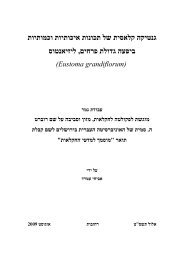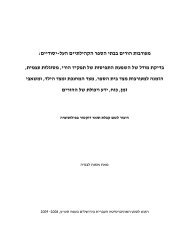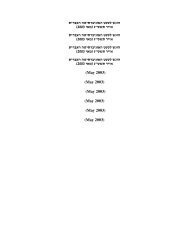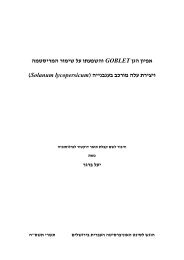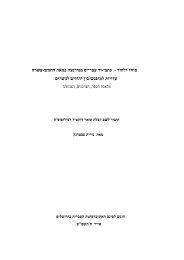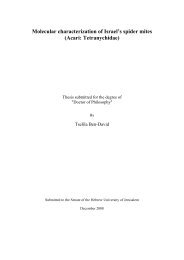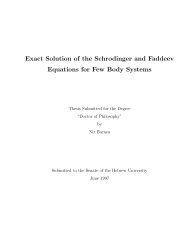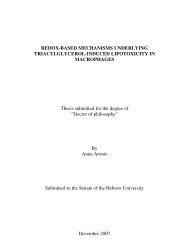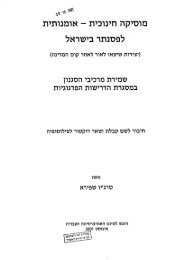Revealing the Mechanism of HSP104 Transcription Initiation in the ...
Revealing the Mechanism of HSP104 Transcription Initiation in the ...
Revealing the Mechanism of HSP104 Transcription Initiation in the ...
Create successful ePaper yourself
Turn your PDF publications into a flip-book with our unique Google optimized e-Paper software.
1<br />
We first noticed that <strong>the</strong> activity <strong>of</strong> <strong>the</strong> full length -334LacZ was decreased<br />
when compared to wild type, <strong>in</strong>dicat<strong>in</strong>g some possible role for Msn2/4 <strong>in</strong> <strong>the</strong> basal<br />
activity <strong>of</strong> <strong>HSP104</strong> (compare Fig. 5 with Fig. 3). However, unexpectedly, <strong>the</strong> reporter<br />
gene was <strong>in</strong>duced to maximal levels even <strong>in</strong> <strong>the</strong> absence <strong>of</strong> <strong>the</strong>se two transcriptional<br />
activators suggest<strong>in</strong>g that <strong>the</strong> <strong>in</strong>duced activity could be solely provided by <strong>the</strong><br />
HSE/Hsf1 system. Indeed, when we deleted <strong>the</strong> HSE cluster (reflected by <strong>the</strong> -<br />
284LacZ construct), and subjected msn2∆msn4∆ cells to heat shock, <strong>the</strong> reporter gene<br />
was no longer <strong>in</strong>duced <strong>in</strong> response to heat shock, confirm<strong>in</strong>g that <strong>in</strong> msn2∆msn4∆<br />
cells, heat shock responsiveness <strong>of</strong> <strong>the</strong> reporter gene is due to <strong>the</strong> HSEs alone (Fig. 5).<br />
This conclusion is fur<strong>the</strong>r streng<strong>the</strong>ned by measurements <strong>of</strong> <strong>the</strong> mRNA levels <strong>of</strong><br />
<strong>HSP104</strong> <strong>in</strong> msn2∆msn4∆ cells which are normally <strong>in</strong>duced <strong>in</strong> response to heat shock.<br />
A) B)<br />
900.00<br />
800.00<br />
700.00<br />
600.00<br />
500.00<br />
400.00<br />
ras2∆<br />
40.00<br />
35.00<br />
6.5<br />
30.00<br />
25.00<br />
20.00<br />
-HS<br />
Time <strong>in</strong> 39 0 C 0’ 15’ 30’ 60’<br />
SP1ras2∆<br />
SP1RAS2 val19<br />
5hrs<br />
30 0 C<br />
<strong>HSP104</strong><br />
ACTIN<br />
<strong>HSP104</strong><br />
ACTIN<br />
300.00<br />
200.00<br />
100.00<br />
3.3<br />
15.00<br />
10.00<br />
5.00<br />
6<br />
3<br />
1 0.00<br />
-334 -284 -260<br />
0.00<br />
-300 -280 -248 -230 -222 -215 -200 -180<br />
-160<br />
Figure 4. <strong>HSP104</strong> expression is derepressed <strong>in</strong> ras2∆ cells and is regulated exclusively through<br />
STREs. A) Deletion <strong>of</strong> each STRE causes a decrease <strong>in</strong> basal (30 o C) β-galactosidase activity <strong>of</strong> <strong>the</strong><br />
promoter (compare 260 vs. 248; 222 vs. 215; and 180 vs. 160). The graphs shown are different <strong>in</strong><br />
scale. The numbers above some bars describe <strong>the</strong> fold reduction <strong>in</strong> activity as compared with <strong>the</strong><br />
previous bar. B) S1 analysis <strong>of</strong> <strong>HSP104</strong> mRNA <strong>in</strong> ras2∆ and RAS2 val19 cells.<br />
Our deletion analysis, <strong>in</strong> comb<strong>in</strong>ation with <strong>the</strong> effects <strong>of</strong> <strong>the</strong> po<strong>in</strong>t mutations,<br />
strongly suggests that <strong>the</strong> derepression <strong>of</strong> <strong>the</strong> <strong>HSP104</strong> promoter <strong>in</strong> ras2∆ cells is<br />
mediated exclusively via STREs. These STREs must be recognized by Msn2 and<br />
Msn4, as <strong>the</strong>y are not functional <strong>in</strong> msn2∆msn4∆ cells (see Fig. 5).<br />
14



